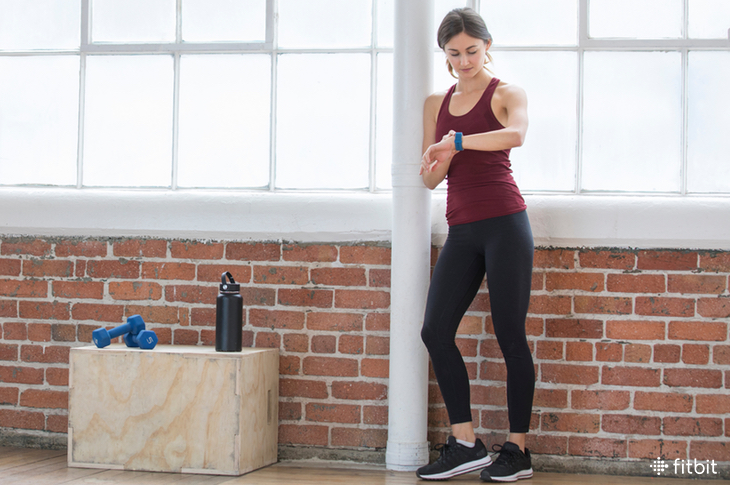 Whether you’re new to muscle-toning moves, or just looking to reintegrate them into your training, the rep-set-rest format of strength training could catch you off guard. Chances are you know about the importance of repetitions—the number of times you perform an exercise—and sets—the number of times you repeat that group of reps—but rest? That’s probably not something you plan for. But you should.
Whether you’re new to muscle-toning moves, or just looking to reintegrate them into your training, the rep-set-rest format of strength training could catch you off guard. Chances are you know about the importance of repetitions—the number of times you perform an exercise—and sets—the number of times you repeat that group of reps—but rest? That’s probably not something you plan for. But you should.
Pushing yourself hard and then sitting idly between sets or, worse yet, texting or chatting on your phone while you walk around isn’t the best gameplan. In fact, research shows that the latter can significantly throw off your balance and stability—possibly putting you at risk for falls and injuries.
Instead of using your rest period as an excuse to veg out or catch up with friends, use it to further your fitness with these tips.
1. stretch it out
“Stretching for 15 to 30 seconds between sets helps lengthen tight muscles, increase range of motion, and improve muscle-fiber recruitment during lifts,” says Adrian Richardson, a workout curriculum designer and certified personal trainer for Fitbit Coach. Here are a few stretches you can try, broken down by body part:
Towel Triceps Stretch
Muscles Targeted: Chest and triceps
Directions:
- Grab a gym towel with one hand, and lift that arm straight into the air.
- Bending at the elbow, let the towel dangle down behind your body.
- Reach behind your back with your opposite hand, and grab the opposite end of towel.
- Pull the towel down with your lower arm until you feel a stretch. Hold for 15 to 30 seconds.
- Switch arms and repeat.
Fixed-Bar Lat Stretch
Muscles Targeted: Back
Directions:
- Face a stationary bar or rack that’s at waist height and firmly grasp the bar with your hands, roughly shoulder-width apart.
- Bending at the knees, sit your hips back and down. You should feel a stretch through your upper back.
- Hold, then repeat on the other side.
Piriformis Stretch
Muscles Targeted: Glutes
Directions:
- Using both hands, hold a stationary bar (that’s at roughly waist-height) for support.
- Slowly bend your knees and hinge slightly forward at the hip.
- Cross your left foot over your right thigh, and sit deeper until you feel a stretch. Hold for 30 seconds.
- Switch legs and repeat.
2. Track Your Progress
Logging stats like the amount of weight used and the number of reps and sets completed allows you to monitor how you’re progressing and how far you’ve come (great for days when you need a motivational boost). Set an exercise goal in the Fitbit app and then track your progress using your Fitbit device.
3. Check Your Heart Rate
Knowing your beats per minute, gives you data on both your effort level and cardiovascular conditioning. “Working hard is more than just being out of breath,” says Richardson. “If you’re training correctly, your heart rate should come back down to the same level between sets on rest periods. For instance, if your heart rate goes from 95 bpm to 60 bpm during your first rest between sets, it should stay within that range for every set of that movement. Logging your heart rate between sets can help you decide when to back off or push harder, making overtraining less likely.”
4. Change Things Up
Whether you’re working on widening the stance of your squat or keeping a flat back during deadlifts, take some time during your rest period to tweak your training. People who slightly modify their routine—like swapping barbells for dumbbells—learn a skill twice as quickly as those who keep subsequent practice sessions exactly the same, according to Johns Hopkins University research.
5. Supplement With A Superset
Feeling up for a challenge? Consider integrating supersets into your routine. A superset is when one set of an exercise is performed directly after the other without rest in between. By eliminating your rest period, supersets can increase your heart rate in a shorter period of time—boosting the overall intensity of your workout and burning more calories in less time. And, since you’ll complete your workout faster, you’ll have more time to go about your day (and fewer excuses to skip the gym).
6. Engage In Active Recovery
People who practice active recovery between bouts of high-intensity running clear lactate faster than those who engaged in passive recovery, according to a study in the Journal of Sports Sciences. And there’s some evidence that the more intense your active recovery is, the faster lactate will clear. Why does this matter? While lactate is no longer seen as the main culprit of muscle fatigue, lactate levels appear to rise and fall in sync with the body properties that are involved. Richardson’s advice: Instead of just sitting around and waiting between sets, do some light cycling on a stationary bike to keep muscles warm and pliable.
This information is for educational purposes only and is not intended as a substitute for medical diagnosis or treatment. You should not use this information to diagnose or treat a health problem or condition. Always check with your doctor before changing your diet, altering your sleep habits, taking supplements, or starting a new fitness routine.

If you have questions about a Fitbit tracker, product availability, or the status of your order, contact our Support Team or search the Fitbit Community for answers.
Please note: Comments are moderated and may not appear immediately after submission.